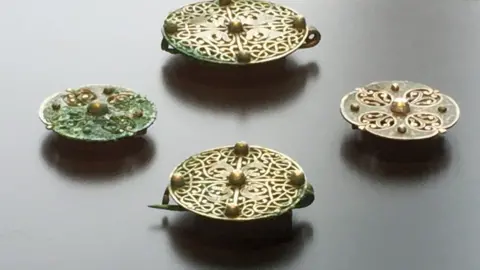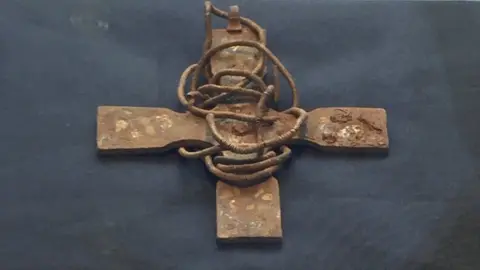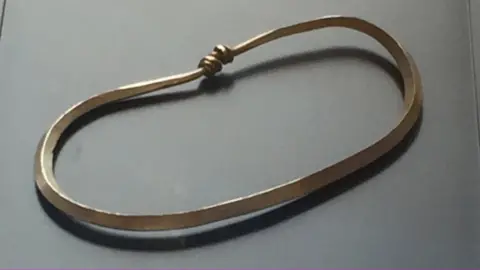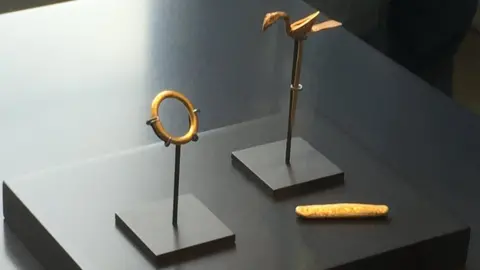Galloway Viking hoard goes on public display in Edinburgh
 BBC
BBCIt has been an unusual and not entirely straightforward journey.
After more than 1,000 years underground - and nearly three since its discovery - part of the Galloway Viking hoard is going on public display in Edinburgh.
A collection of "international significance", it comprises more than 100 gold, silver and other items.
There is understandable excitement at the National Museum of Scotland at being able to give a glimpse of its treasures to a wider audience.
In future, it is planned, it will also go on show in Kirkcudbright - closer to the spot it was discovered.

It was September 2014 when metal detectorist Derek McLennan made the discovery of a lifetime on land in Dumfries and Galloway.
Buried at the beginning of the 10th Century, some of the artefacts date back to an even earlier period.
The hoard brings together the richest collection of rare Viking-age objects ever found in Britain.
"It is very exciting to finally have the hoard on display," said NMS senior curator Dr Martin Goldberg,
"To see it all laid out together for the first time is a real eye-opener for me - just seeing how much there is."
Silver jewellery
He said a small treasure vessel in particular had produced some remarkable finds.
"It is amazing - it is only 10cm high and 10cm in diameter - but the amount of things that were packed into it that we can now put on display," he said.
The range of items spread out across the glass cabinets on display is impressive - the bulk of it silver jewellery and ingots.
A tiny, gold, bird-shaped pin is particularly eye-catching as well as a number of brooches - some of a kind never previously found in Scotland.
The temporary display of the hoard - which runs until October - is aimed at helping to raise funds towards the nearly £2m required to "save it for the nation".
That process has not been without controversy.

Dumfries and Galloway Council had put in a bid to secure the hoard for a new art gallery being built in Kirkcudbright but that was ultimately unsuccessful, despite going to appeal.
NMS has pledged to put part of the collection on permanent display in the town in due course and, on occasions, let all the artefacts come to the region.
Not everyone in Dumfries and Galloway is happy with that outcome but NMS director Dr Gordon Rintoul insisted it was the right one.
"This hoard is of major national and international significance but it also needs a lot of work done," he said.
"It is going to take a conservation programme which we think is going to take at least two years."

He said a lot of specialised expertise and equipment would be needed to carry out that work.
"It is also going to need a lot of very detailed academic research to uncover its secrets - there are lots of mysteries around some of the items in the hoard," he said.
Dr Rintoul said that meant the museum in Edinburgh was the right place for the items.
"But it has always been our intention to aim to acquire it for the nation and to share it with others including Dumfries and Galloway Council," he stressed.

"We have been in dialogue with the council since last October and we remain in dialogue now.
"We have actually re-iterated since the hoard was allocated to ourselves that we want to see a proportion of it on long-term display in the new Kirkcudbright art gallery."
Those details have still to be thrashed out but, in the meantime, the first chance for the public to get a look at the artefacts starts at the National Museum of Scotland on Friday.
The items which were hidden under the soil of south-west Scotland for so long are on display until 1 October.
But the mysteries that they hold might take a lot longer to unravel.
